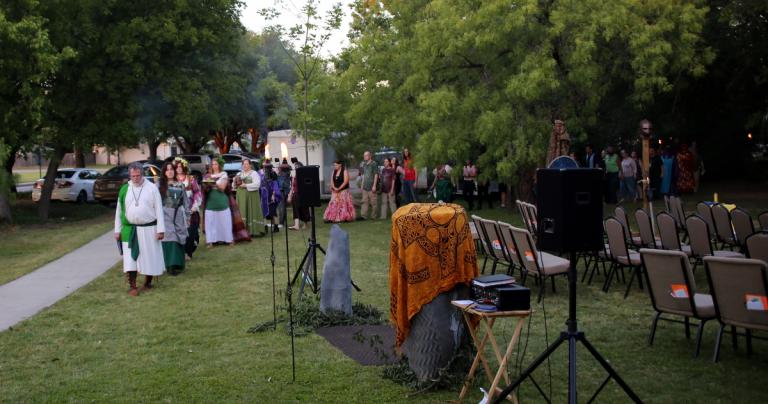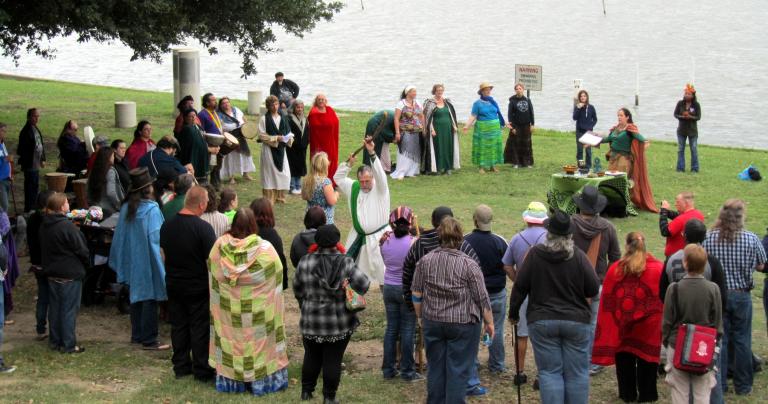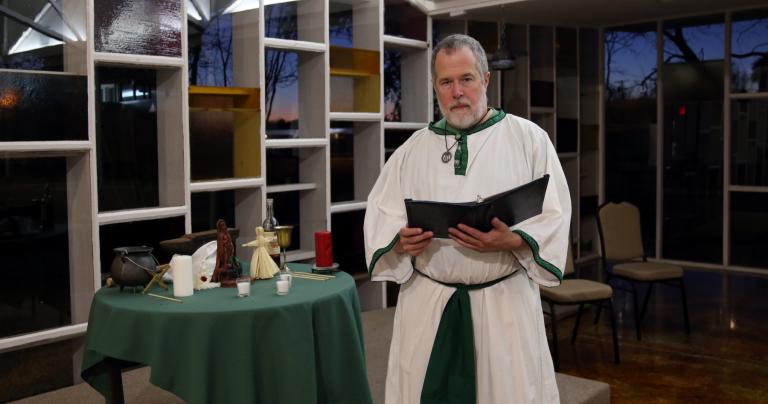You were a solitary Pagan for years, but you finally went looking for a group. Except there wasn’t an established coven or grove near you. You found a meetup group, or a discussion group, or a UU chalice group that wanted to explore Paganism. They were nice people, but nobody really had much experience. And so when the group decided it was time to do a public ritual, everybody looked at you.
And you said yes.
Now what?
If you were in an ADF grove you’d know exactly what to do: the Core Order of Ritual. If you were in a Gardnerian coven you’d do Gardnerian Wicca. But your group has a couple people wearing pentacles, one wearing a Thor’s Hammer, and a few people who like to talk about magic and Nature. How are you going to make all those people happy?
It’s not your job to make them happy. It’s your job to coordinate a good, effective ritual for everyone in attendance. And that can be done.
Understand what a ritual is
A ritual is a series of interrelated actions designed to accomplish a spiritual goal. It may be a celebration, but it’s more than a party. It may honor certain spiritual persons, but it’s more than singing praises. It may work magic, but it’s more than a spell.
Planning a ritual begins with a goal. What are you trying to accomplish? What do you want people to remember as they’re driving home, or as they’re cooking dinner the next week? That need not be a major transformative experience – most times it won’t be. “We celebrated Imbolc and I learned something about Brighid” is a very appropriate goal.
All your ritual elements should support your goal. If someone runs to you shouting “I found this cool poem – let’s put it in the ritual!” your first question should be “does it fit what we’re doing?” If the answer is no, file it away for a future ritual where it does fit.
Taken together, all the elements (the liturgy, or in UU terms the order of service) form a framework for the ritual. They create a container for the working.
I go into depth on this in The Path of Paganism. For now, read A Pagan Ritual Outline. I’ve made some tweaks to that liturgy over the years, but it’s still a good place to start.
What will your audience expect?
I hate calling guests at a public ritual the audience. It implies that we’re performers and they’re consumers of entertainment. Done right, the people who present the ritual are facilitators and the other folks are participants. The more participative you can make your ritual the better it will be.
But many of the people who attend a public ritual – particularly if it’s their first time – will have expectations like an audience. And as I’ve been recently reminded, you have to meet people where they are.
Very few people attend a Pagan ritual knowing absolutely nothing about Paganism. They have a friend who’s a Pagan or they’ve read a Wicca 101 book. They’ve seen Pagan rituals in TV and movies. What they learned will be incomplete and it may be wrong (in part if not in whole) but that’s where they are. That’s where you have to meet them.
There are at least three things they’re going to expect: circle casting, quarter calls, and a simple feast.
Circle casting isn’t just for Wiccans
Is circle casting creating sacred space? Is it creating a barrier against baneful spirits? Is it cleansing and blessing the space where you work? It can be any or all of that, depending on what you do and how you do it. The main thing it does is to declare “this space is dedicated to this rite for the duration of the rite, and not for anything else.”
Calling the spirits of the directions orients the ritual in the Universe. It says for this moment, we stand in the center, and from here we can go in any direction. It calls the spirits of the elements to help us re-create the cosmos for our ritual.
In 2017 I wrote Why I Still Cast Circles and Call Quarters. I’m a polytheist who leans heavily on reconstructionist methods and I’m fully aware that this isn’t exactly what our ancestors did. But it works, so I do it.
And once you invoke the spirits of the elements and directions as people expect, it’s easy to add on invocations of the spirits of the land, the ancestors, and the deity or deities of the occasion – which they’re probably not expecting.
Sharing food and drink is among the oldest of religious customs, whether as an act of hospitality or as a reversion of offerings. It has the practical advantage of grounding participants in the ordinary world, which is especially important if your ritual was magical or Otherworldly.
Give beginners what they expect and they’ll be more open to receive what you want them to take away.
Make it theologically consistent
This can be a huge challenge in a mixed group. The Wiccan in your group wants to invoke The Goddess, the Heathen wants to invoke Freya, and someone else wants to invoke the Earth as mother of us all. Behind all these desires is a theology, which is usually some form of polytheism, duotheism, or pantheism. Or in some cases, non-theism.
You have to choose one.
If you’re doing a polytheist ritual, invoking The Goddess and The God doesn’t work. If you’re doing a naturalistic ritual, making devotional offerings to the Morrigan isn’t consistent. I’m a polytheist and any ritual I lead will be polytheist in structure. I will soften my tone if necessary (and it’s frequently necessary in a public ritual), but all the ritual elements will support the idea that there are many real God who are worthy of our devotion and worship.
But if someone else in Denton CUUPS wants to lead a ritual to the Great Mother, I’ll do everything I can to help them with it. A CUUPS group should be inclusive of all forms of Paganism consistent with UU values.
Beyond that, make sure the ritual is culturally consistent. Some of the worst rituals I’ve ever seen were mash-ups that tried to make everybody happy and ended up being bland, discordant, and appropriative. If you’re doing Hellenism, do Hellenism. Don’t do Wicca with Greek Gods.
And speaking of cultural appropriation, John’s first rule is “don’t pretend to be something you aren’t.” This is especially true when drawing from religions and cultures that have been (and in many cases, still are) oppressed. You don’t honor Native Americans by dressing up and playing Indian.
Whatever you do, do it well
I cannot overemphasize this point. Good intentions aren’t enough. Writing a good script isn’t enough. You have to present the ritual effectively and professionally. It may be your first time, but it shouldn’t look like it’s your first time.
As you’re composing and assembling the ritual, don’t just write out the words you want people to say. Include stage directions. Visualize the ritual as you write it – are you asking someone to do something that requires three hands?
Consider the size of your ritual. What works well for a close-knit coven of 13 won’t work in a public gathering of 30, and what works for 30 won’t work for 100.
Rehearse the ritual before you do it for real. If it’s the first time for your group, this probably means a special rehearsal sometime the week prior to the event. Go over everything, especially movements.
Memorizing parts is great – if everyone can and will do it. If you’re not all semi-professional actors, it’s probably best to read. Print scripts and put them in binders – shuffling loose papers or stapled scripts is a distraction for the participants.
Dress the part. Robes are great, but if you don’t have ritual garb then wear nice ordinary clothes. And for the sake of all the Gods, don’t wear silly t-shirts. You may not be a priest, but for the duration of the ritual you’re serving as a priest. Look the part.
I’ve been doing public rituals for 15 years and I still haven’t done one perfectly. But when we try for perfection, what we end up with is usually pretty good.
Everybody has a first time
If we lived in a Pagan society we’d all see good (and not so good) Pagan rituals all the time. There would be temples where we could learn how to lead rituals from professional priests, either by observing them or by apprenticing with them. But we don’t live in that society, at least not yet.
Some of us are fortunate enough to have good teachers. Most of us have to figure it out on our own.
Want to read about my first time leading a public ritual? Read Lessons From a First Ritual. There are some helpful links in it as well.
Understand what you’re trying to do. Figure out what your audience expects, what they need, and what they’re ready to see and do. Make sure it’s theologically and culturally consistent. Rehearse it, multiple times if necessary.
Then may the Gods, the ancestors, and the spirits of Nature bless your ritual and the work you do for your community, in this world and in the world beyond.



















